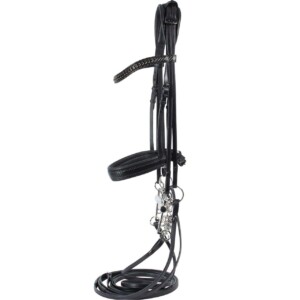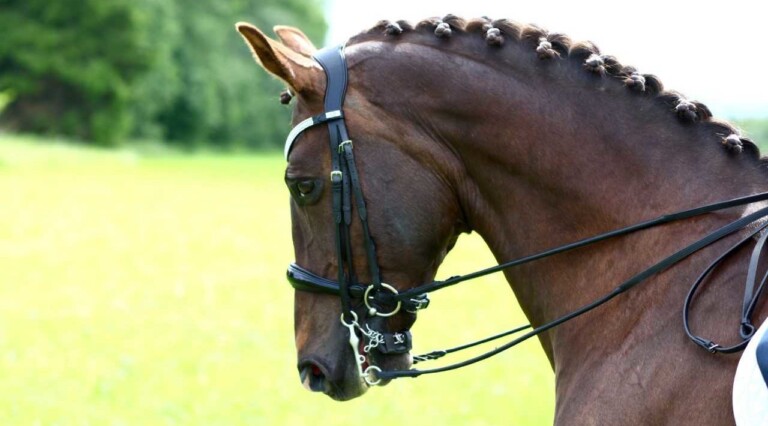The double bridle is an easily misunderstood item of tack. In the right hands it is a delicate instrument of communication with the horse in the higher level of dressage. Used in the wrong way, writes Dannii Cunnane, it can be harsh on the horse and cause problems that did not exist before.
Most trainers and riders have a different opinion on when to introduce the double bridle. Traditionally it was thought that the double should be not be introduced until a horse is in its fifth year, but there are many factors at play.
Ideally before a horse is introduced to a double bridle the horse must be going forwards properly in their work. This means they must be accepting a snaffle bridle and engaged behind – it’s all about the horses self-carriage and lightness. If this basic foundation is not met, it is not time to introduce the double bridle until it is. It’s vital for the horse’s performance longevity not to rush the horse and shove hardware into their mouth for which they are not ready.
While it may be tempting to put one on and simply ride, the double must be treated with respect. It needs correct training for the horse and rider else it is very probable that it will create issues that were not present with the snaffle. So before we move forward, let’s find out more about what the double bridle is and what purpose it served.
The double bridle consists of two bits: the bridoon (snaffle bit) and the curb. The centre of all discussion is the curb bit as it is the most delicate instrument. The way it is fitted and the way it is handled decides if the curb is one of brute force or one that refines riding.
Historically the curb was invented to serve as a tool of force because it was a bit that enabled knights and cavalrymen to control their horses one-handed in dangerous situations in which control could be the deciding factor between life or death.
It was only during the Renaissance in France that riding masters, most notably Pluvinel and de la Guérnière, discovered and began to spread the awareness that the curb bit can be used (back then occasionally in combination with a cavesson) as an instrument that enables the rider to ride with a higher level of communication with the horse.
Gradually the double bridle came to be considered an essential part in the art of riding dressage, because correct usage leads not only to refined communication, but also increases the horse’s collection. To understand how this happens let’s take a closer look at the way the double bridle works.
The purpose of a double bridle
Both bits of the double bridle fulfil two completely different tasks.
The bridoon (snaffle) acts by elevating and bending the horse whereas the curb causes the horse to give the neck and bring the head towards the vertical. It is the hand of the rider that initiates the desired head and neck position of the horse with the help of the double bridle. However the rider is never allowed to use it as a tool to force the horse into a specific head and neck position. To do this is cruel and defeats the point of riding – it’s all about horsemanship and the horse being comfortable, light and receptive to the hand.
There is no doubt that the correct use of the double bridle leads to improved collection and self-carriage. Consequently the correct use of the double bridle has become inseparably linked to the concept of the classically and well-schooled horse. The activity of the hind legs of a well-trained horse creates a flow over the back and into the rider’s hand. This corresponds with the concept of riding a horse from behind to the front; the only way natural for a horse.
All of this means that a horse is only ready for the double bridle when it has gained a certain degree of collection since at the level it has also already obtained a certain degree of self-carriage.
Collection means that the horse increases the activity of its hind legs, takes more weight by bending the joints, and comes towards the vertical, has risen in the withers and has a strong top line.
But while the usage of the double bridle requires a horse to have collection, it can also increase the amount at the same time. How does this happen? Due to the curb the rider is able to give very refined and minute impulses. The energy of the hind legs flowing to the front gets redirected very promptly back onto the hind legs and as a result the collection and self-carriage improve.
Taking the above information into account, the requirement and use of the double bridle in higher-level dressage seems to make great sense. However, the sense of the curb is questioned more and more as a direct consequence of the totally wrong use of the double bridle as seen in negative images of dressage with gaping mouths and blue tongues as a firmly pulled curb is pressing on the tongue. It is very disturbing to any horse lover to see these images, but often hard for those who are not riders to understand that these images absolutely do not reflect the correct usage of the double bridle.
Each horse has different needs so the snaffle and curb must be fitted comfortably. Conformation of the mouth is so important.
When fitting a double brilde the length of the jaw is incredibly important. This is because horses, especially Thoroughbreds and ponies, have tiny mouths and it can be difficult, sometimes even impossible to fit a double.
You also need to look at how low the molars are – with geldings, the tushes are not always in the correct place and may cause the hardware to bang against them. It’s vital to make sure the teeth are checked regularly by a good equine dentist, preferably one who sedates and does whole of mouth equine dentistry.
Also, some horses have big, fleshy tongues. This must also be taken into account and if this is the case for a horse the use of an arched mouth Weymouth or one with a higher port to make more room for the tongue will work.
The length and type of cheek piece add another dimension. Some horses go better with a sliding cheek, others with a fixed cheek. The horse who is naturally light or tends to come behind the bit would usually be happier with a fixed cheek, while a sliding cheek would be better for one who is inclined to lean. Similarly opt for a loose ring bradoon for a horse who needs more play on the mouthpiece and an eggbutt for one who responds better to a mouthpiece which stays relatively still.
The type of curb chain used is also important. You have to be flexible and work out what suits the individual horses. Horses do not like chains banging around their mouth so ensure the one you use is suitable for your horse and cut to size. Ensure your chain is perfectly flat never twisted otherwise it will cause pinching and discomfort.
Obviously it’s important then to know when to introduce the double bridle, and in short, the double bridle must only be introduced when the horse is ready and when the rider is skilled enough to use it correctly. It should never be placed in the hands of someone who wishes only to use it because it looks good . Using a double bridle too soon can result in anxiety in the horse, mouth problems and irreparable damage.
In hacking it is used as the rider decides, but in dressage it is introduced at Medium level the level at which the horse’s collection is now established. While it might look nice and grown up to be in the double bridle, ensure your horse’s welfare comes first and that it is being used for the right reasons.
Printed in HorseVibes July 2018
[aigpl-gallery id=”16863″ grid=”1″ link_target=”self” gallery_height=”auto” show_title=”true” show_description=”false” show_caption=”false” image_size=”full” popup=”false” object_fit=”contain”]



